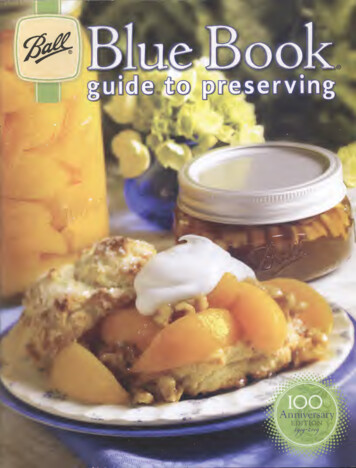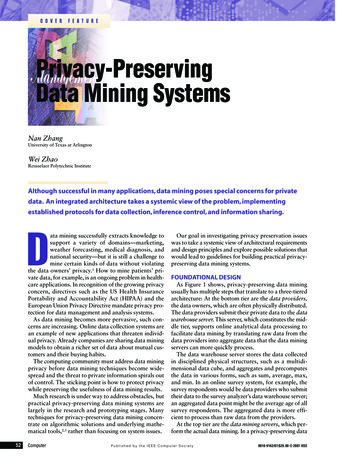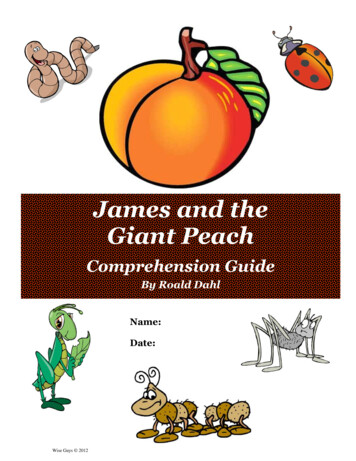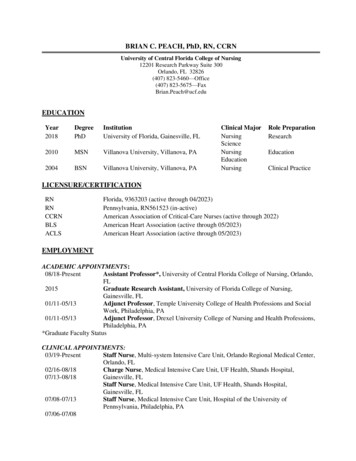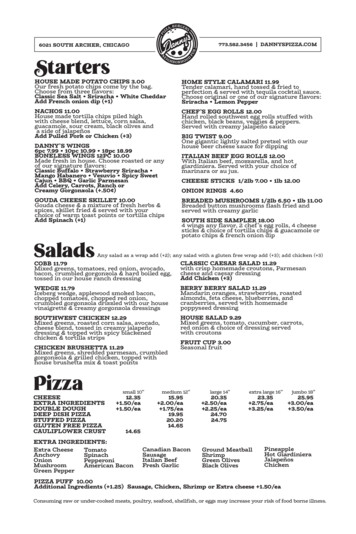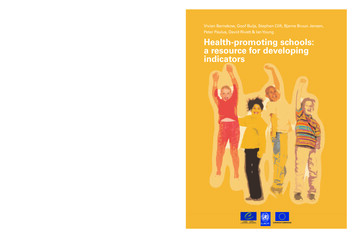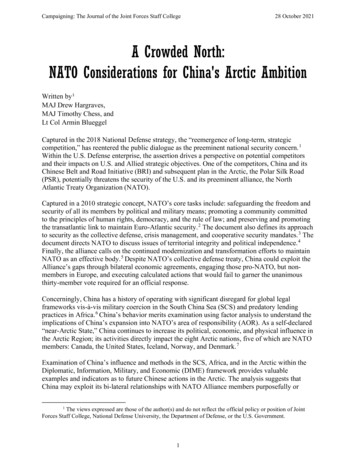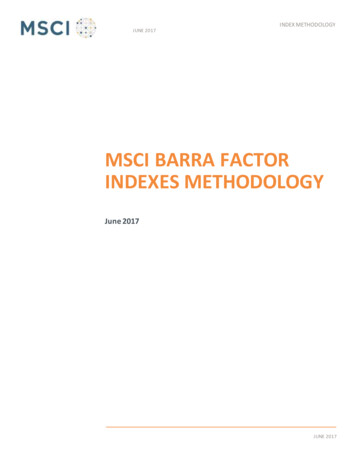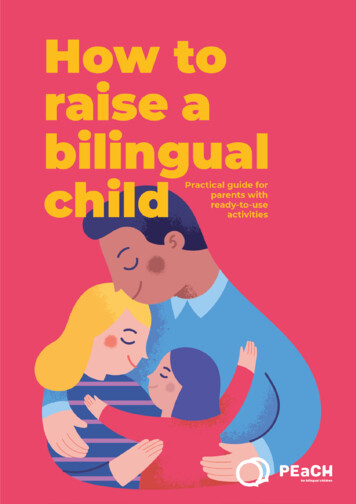
Transcription
How to raise a bilingual child – practical guide for parents1PEaCH – Preserving and promoting Europe’s cultural and linguistic heritage
How to raise a bilingual child – practical guide for parentsHow to raisea bilingual childPractical guide for parents withready-to-use activitiesAuthorsCatherine BoukoJulie CartonUte Limacher-RieboldMary-Pat O’MalleyRita RosenbackProject2019-1-BE02-KA201-060323 PEaCH Project & Authors 2020The European Commission’s support for the productionof this guide does not constitute an endorsement of thecontents, which reflect the views only of the authors,and the Commission cannot be held responsible for anyuse which may be made of the information containedtherein.2PEaCH – Preserving and promoting Europe’s cultural and linguistic heritage
Table of contents122.12.2Welcome7About the Project9How does this guide work?9What is happening?AdviceActivitiesWhat if I start now?Questions and answers1011111212Some reminders before we start13Benefits & myths14Benefits of being a bilingual15Communication skillsMulticulturalPersonalityFamily cohesionCognitive advantagesEducational successHealth advantages15151616161717Debunking myths18Bilingual children have a language delayChildren get confused by hearing more than one languageChildren will automatically pick up the languages the parents speakBilinguals should not mix their languagesBilingualism is detrimental to school successBeing bilingual means being fully and equally fluent in two languagesAfter childhood it’s no longer possible to become a fluent bilingual18181919202122
Who should speak what when - choosing the familylanguage strategy233.1How to choose the right strategy243.2Common strategies25One Person – One LanguageMinority Language at HomeTime and PlaceTwo Parents – Two Languages252626283.3Bilingual siblings283.4Questions and answers30Your child’s bilingual journey37Before your baby is born38What is happening?AdviceActivitiesQuestions & answers38394040Zero to 18 months42What is happening?AdviceActivitiesWhat if I start now?Questions & answers424445464718 to 24 months48What is happening?AdviceActivitiesWhat if I start now?Questions & answers4849505253Two to four years54What is happening?AdviceActivitiesWhat if I start now?Questions & answers5456565959344.14.24.34.4
4.5Four to six years61What is happening?AdviceActivitiesWhat if I start now?Questions & answers6163646869Six to nine years70What is happening?AdviceActivitiesWhat if I start now?Questions & answers7072757980Nine to twelve years83What is happening?AdviceActivitiesWhat if I start now?Questions & answers8385889293How to positively deal with resistance from others955.15 tips965.2Questions and Answers98Children who are late talkers1046.1A few important things to keep in mind1056.2What is late talking?107How can I identify late talking in my child?Do they grow out of it?1081086.3When should I see a speech & language therapist (SLT)?1106.4What can I do to help?1104.64.756
7Let’s end on a high note!1128Glossary1149Q&A index11810Resources12011Authors and contributors12212Bibliography1256
How to raise a bilingual child – practical guide for parents1Welcome7PEaCH – Preserving and promoting Europe’s cultural and linguistic heritage
How to raise a bilingual child – practical guide for parentsWelcome to the PEaCH guide forparents raising bilingual children!Dear parent of a bilingual or a bilingual-to-beIf you are reading this, chances are that you have made the gloriouschoice of raising a bilingual child. What’s more, you have come to theright place to find out how to do it! Our PEaCH guide has been designedto accompany you on the journey of bilingual parenting. It will help youto understand how bilingualism works, to turn it into a fun and rewardingexperience for you and your child, and to tackle any challenges along theway.Bilingualism as a concept is broader than many people think. In the PEaCHproject, we stand by the definition of François Grosjean, renowned professor in psycholinguistics:“a bilingual is someone who regularly uses two or more languages or dialects in their everyday lives.”If you think about it, that covers a lot of people - more than half of theworld’s population, actually! Note that Grosjean doesn’t mention a certain level of fluency required to be considered bilingual, or a specificnumber of languages. This is an important message. As long as you usemore than one language, in whichever way or at whichever level, you arebilingual. Why are we telling you this? To take the pressure off you, andhelp you get started with the right mindset. Whatever level of fluency yourchild reaches in each of their languages, you are doing a wonderful joband giving them an invaluable gift.8PEaCH – Preserving and promoting Europe’s cultural and linguistic heritage
How to raise a bilingual child – practical guide for parentsAbout the projectThis guide for raising bilingual children is one of the outcomes of PEaCH,an Erasmus project funded by the European Commission. The acronymPEaCH was derived from the main goal of our project: ‘preserving andpromoting Europe’s cultural and linguistic heritage through empowerment of bilingual children and families’. Focusing on the 24 official EUlanguages, PEaCH wants to help both parents and educators of bilingualchildren to support their family languages. On our website, parents canconsult this guide, as well as a large online collection of language learningmaterials in all EU languages and a set of videos with tips on how to passon and maintain the family language(s). For teachers and educators, theproject will develop a toolkit, providing advice on how to create a positive multilingual environment in the classroom and support parents inpassing on the family language to their children. The PEaCH guide ‘Howto raise a bilingual child’ is the first of the materials the PEaCH project willproduce to support and promote bilingualism among EU families.How does this guide work?Our guide is structured in a way that you can easily navigate towards sections that apply to your family situation. Here’s an overview of the different chapters.If you are still in any doubt as to whether or not to embark on this journeyand need a final nudge, you may want to start with the chapter on mythsand benefits, where you’ll find a list of valid, research-based reasons whyraising a bilingual child is always a valuable choice, and some commonmyths debunked.Bilingual parenting starts with a plan. Before embarking on the journey,you decide where you want to go and how you want to get there. In the9PEaCH – Preserving and promoting Europe’s cultural and linguistic heritage
How to raise a bilingual child – practical guide for parentsfirst chapter, Who should speak what when - choosing the family languagestrategy, we encourage you to think about your goals and come up with astrategy that will help you achieve those goals.And then it begins: your child’s bilingual journey. In this main part of thehandbook, we follow your child from the womb through to the age oftwelve. The journey unfolds in seven age brackets, centred around important steps in your child’s development. Keep in mind that these agebrackets are by no means fixed. Language is not an exact science. Everychild’s language development is a unique evolution with several varyingfactors, so it’s best to focus on steady progress instead of numbers. Theage brackets are there to give a rough indication of what you can expect.1 pregnancy2 zero to 18 months3 18 to 24 months4 two to four years5 four to six years6 six to nine years7 nine to 12 yearsWithin each age bracket, you’ll find the following subsections:What is happening?A clear overview of children’s language development from amultilingual perspective.While a lot of it happens inside your child’s head, there is more to development than genetics and buzzing brain cells. As children grow up, theirlanguages interact with a whole range of social, educational and relational factors, which merge into one unique story. ‘What is happening’ helpsyou understand your child’s bilingual journey.10PEaCH – Preserving and promoting Europe’s cultural and linguistic heritage
How to raise a bilingual child – practical guide for parentsAdviceTips and guidance on how to approach the journey of bilingual parenting.How can you support and motivate your child? What is an optimal environment to foster bilingualism? What can you do to make your child feelconfident?ActivitiesA list of ready-to-use activities you can do with your child tohelp develop and maintain their home language skills.How to help them understand the home language, learn and pronouncenew words, speak fluently, and so on. In the last three age brackets, wepay special attention to literacy skills in the home language. This is specifically for parents who want to foster their child’s reading and writingskills. Note that you are not expected to do all the activities. They aresorted from minimal to maximum effort, so you can choose the onesthat correspond to your child’s ability, and adjust them according to howmuch time or resources you have. Regularity is key. The more you repeatan activity, the better your child will learn and remember. You’ll find thatsome activities refer to our PEaCH resources. These are templates thatyou can download from our website. In some activity sections, you’ll finda culture & heritage box with tips on how to integrate your cultural heritage into the language activities.11PEaCH – Preserving and promoting Europe’s cultural and linguistic heritage
How to raise a bilingual child – practical guide for parentsWhat if I start now?Advice for parents who want to introduce a second languageat a later stage in their child’s life.The path laid out in this handbook implies that your child’s bilingual journey starts from birth, but that’s not always the case. Some parents speakthe majority language with their child from birth and don’t introducetheir native language until later. For each age bracket, you will find tipson how to introduce your native language at that particular time in yourchild’s life.Questions and answersFrequently Asked Questions that reflect insecurities, worriesor challenges shared by many parents of bilingual children.The Q&A’s are sorted by age, but at the end of the guide there is a Q&A indexthat lists all the questions by topic.After covering your child’s bilingual journey until the age of twelve, thisguide finishes with a few important aspects of bilingual upbringing in moredetail. The chapter How to positively deal with resistance from others willtell you how best to react to people who express judgment or negative opinions about your choice to raise a bilingual child. In Children who are latetalkers, speech and language therapist Mary-Pat O’Malley explains whatlanguage delay is, how parents can spot it and what can be done about it.At the end of the guide, you’ll find a glossary with explanations of someimportant terms that are used regularly throughout the guide.12PEaCH – Preserving and promoting Europe’s cultural and linguistic heritage
How to raise a bilingual child – practical guide for parentsSome reminders before we startThe age brackets are not set in stone. They’re a rough indication of what to expect; every bilingual child follows its ownpath. You are the best judge of your child’s abilities. If you feelthat they aren’t ready for a certain activity, have a look at theprevious age brackets. It’s also possible that an activity for ages6 to 9 is perfectly tailored to your 5-year-old.In the same vein: do not compare your child to other children.There are no two children with an identical journey. Focus onyour child’s individual progress.Being bilingual does not mean that you have to be fluent andknow how to read and write. Choose what works for you andyour family.Whatever you can do to help your child learn your language isa plus!It’s never too late to take the first step.13PEaCH – Preserving and promoting Europe’s cultural and linguistic heritage
How to raise a bilingual child – practical guide for parents2Benefits& myths14PEaCH – Preserving and promoting Europe’s cultural and linguistic heritage
How to raise a bilingual child – practical guide for parents2.1 Benefits of being a bilingualIf you have made the wonderful decision to raise a bilingual child, youcan turn to this guide for information, activity ideas and answers to yourquestions. But what if you haven’t decided yet? What if you’re strugglingwith the ‘why’ question? It’s easy to get lost in all the websites and leaflets, and you might have trouble weighing up the pros and cons. ‘Cons’is a wrong choice of words, though. There really are no cons to raising abilingual child. If anything, your child will benefit from it in many ways.Sure, you might stumble across challenges every now and then, but isn’tthat inherent to the bumpy yet rewarding ride that is parenting though?The most important message to remember is that whatever you can doto help your child learn your language will be worth it. If you’re having doubts about the value of raising a bilingual child, or if you need areminder of why you’re doing it, here is an overview of the opportunitiesand advantages bilingualism will bring to your child.Communication skillsBilinguals are sensitive and responsive to the communicative expectations and needs of their conversation partners, because they are better attaking other people’s perspectives.MulticulturalBilinguals are gifted with two worlds of experience instead of one. Thebest way to immerse in another culture and really connect with it, is tospeak the language of that culture. On top of that, bilingual children canbe a bridge between cultures and contribute to cross-cultural communication, as speaking the languages makes it easier for them to understandcultural differences.15PEaCH – Preserving and promoting Europe’s cultural and linguistic heritage
How to raise a bilingual child – practical guide for parentsPersonalityBilinguals tend to be more tolerant and show higher levels of empathy.Family cohesionRaising bilingual children who can speak the language of their family andfriends abroad sustains important relationships and cherished traditions.Cognitive advantagesBilingualism does not only give you an advantage in terms of languageskills – it enhances other cognitive functions as well. Bilinguals tend to16PEaCH – Preserving and promoting Europe’s cultural and linguistic heritage
How to raise a bilingual child – practical guide for parentsbe more creative, they are better able to focus, and have an innate talentfor multitasking and abstract thinking. They perform better at tasks thatrequire conflict management and are likely to develop a higher level ofmetalinguistic awareness.Educational success1Bilingual children are generally more likely to finish secondary school2and attend higher education3 . They are also more likely to get hired forthe job they applied for4 . Listing more than one language on your resumeis a nice bonus of being bilingual, isn’t it?Health advantagesSeveral studies have shown that lifelong bilinguals are better protectedfrom the symptoms of dementia5 . On average, symptoms develop fiveyears later in bilinguals.¹ Rumbaut, R. G. (2014). English Plus: Exploring the Socioeconomic Benefits of Bilingualism in Southern California (SSRN Scholarly Paper ID 2440950). Social Science Research Network.² Feliciano, C. (2001). The Benefits of Biculturalism: Exposure to Immigrant Culture and Dropping out of School among Asian and Latino Youths. Social Science Quarterly,82(4), 865–879.³ Callahan, R. M. (2009). Latino Language-Minority College Going: Adolescent Boys’ Language Use and Girls’ Social Integration. Bilingual Research Journal, 31(1–2), 175–200.⁴ Porras, D., Ee, J., & Gándara, P. (2014). Employer preferences: Do bilingual applicants and employees experience an advantage? In R. Callahan & P. Gándara (Eds.), Thebilingual advantage language, literacy and the US labor market. Multilingual Matters, 236-262.⁵ Alladi, S., Bak, T. H., Duggirala, V., Surampudi, B., Shailaja, M., Shukla, A. K., Chaudhuri, J. R., & Kaul, S. (2013). Bilingualism delays age at onset of dementia, independentof education and immigration status. Neurology, 81(22), 1938.17PEaCH – Preserving and promoting Europe’s cultural and linguistic heritage
How to raise a bilingual child – practical guide for parents2.2 Debunking mythsBilingual children have a language delayThis myth probably arises because it feels to parents like their bilingualchild is delayed in their vocabulary and sentence production comparedto monolingual peers. While bilingual children may know fewer words ina certain language than a monolingual, science suggests that their overallvocabularies are comparable in size if you count them across the two languages⁶ . While it is true that a rather small proportion of young childrendo have difficulties with language, it’s important to keep in mind that bilingualism is never the cause of that. A language delay has nothing todo with how many languages a child speaks. If your bilingual child hasbeen diagnosed with a language or speech delay, you can rest assuredthat raising them in two languages will not do them any harm or worsenthe delay⁷ .Children get confused by hearing more thanone languageBilingual children are not confused by acquiring two languages at the sametime. In fact, regular exposure to two languages from birth is the ‘easiest’road to bilingual success (although there are many possible paths thatwork perfectly fine). Bilingual children can differentiate between the languages they hear already in infancy. From the age of four or five, they startto develop a level of metalinguistic awareness, which means that they areconscious of their two languages and they can reflect upon their languageuse. When their parents each speak a different language to them, they willsoon be able to tell the difference and even reply in the language they arebeing spoken to (that is, if they have learned to speak that language). Try asyou may, you will not find any signs of language confusion.⁸⁶ Rephrased from an interview with Casey Lew-Williams (see Contributors)⁷ Rephrased from an interview with Mary-Pat O’Malley (see Contributors)⁸ Guiberson Mark. (2013). Bilingual Myth-Busters Series Language Confusion in Bilingual Children. Perspectives on Communication Disorders and Sciences in Culturally andLinguistically Diverse (CLD) Populations, 20(1), 5–14. (page 6)18PEaCH – Preserving and promoting Europe’s cultural and linguistic heritage
How to raise a bilingual child – practical guide for parentsChildren will automatically pick up the languages the parents speakWhile it is true that young children learn a great deal by listening and observing, it would be misleading to say that they automatically acquire anylanguage they hear at home. The process of language learning is a complexcombination of beneficial factors. Getting varied and regular exposure toa language is one important thing, but the best way to learn it is to practiseas much as you can and have meaningful, real-life interactions.“Knowing that there is a need for you to speak a language, likecommunicating with a community, family abroad or with yourparents, is an extremely effective motivation for languagelearning.⁹”Bilinguals should not mix their languagesOne of the most widespread misconceptions about bilingualism is the ideathat it is bad for children’s language development when they use both languages in one sentence or utterance. Many people incorrectly see children’s‘language mixing’ (using two languages in one utterance) as a sign of confusion. Much to the contrary, this is rather a display of ingenuity and a normal evolution in bilingual development. It’s been proven that a bilingualchild’s languages develop independently from one another, and that children can differentiate between them from a very early age¹⁰ . When yourtoddler mixes languages, you will notice that the sentences remain correct:they follow the structure of the core language. When a bilingual child uses aGerman word in an otherwise English sentence, he will make sure that it fitsinto the structure of that sentence (Mummy, can I have a piece of Kuchen?).This proves that although bilinguals sometimes combine two languages,⁹ Rephrased from an interview with Casey Lew-Williams (see Contributors)¹⁰ Guiberson Mark. (2013). Bilingual Myth-Busters Series Language Confusion in Bilingual Children. Perspectives on Communication Disorders and Sciences in Culturallyand Linguistically Diverse (CLD) Populations, 20(1), 5–14. (page 6)19PEaCH – Preserving and promoting Europe’s cultural and linguistic heritage
How to raise a bilingual child – practical guide for parentstheir brain can tell them apart. In fact, this language mixing is a naturaland normal evolution. It shows how resourceful your child is. If they don’tknow a word in one language, their brain goes into problem-solving modeand provides it in the other. As your child’s vocabulary develops in both languages, the mixing will disappear eventually. What remains is code-switching, which refers to bilingual speakers alternating between multiple languages in one conversation.Bilingualism is detrimental to school successIt’s possible that your child’s school or teachers have limited knowledge ofbilingualism and therefore don’t know how to deal with a child that speaksa minority language at home. They’re worried that the child will lag behindin school subjects because it doesn’t master the majority language andcannot follow in class. While this may be a genuine concern, it has provento be untrue. Some schools incorrectly advise parents to speak the majoritylanguage at home or forbid bilingual children to use their home languageon school grounds. Unfortunately, the value of the home language for achild’s emotional wellbeing is often overseen in situations like this. It’s animportant part of their heritage and emotional development. Furthermore,bilingualism is associated with cognitive benefits like stronger multitasking skills, creativity and working memory, which can benefit children’sschool performances in several subjects. On top of that, skills in the homelanguage can be transferred to new languages and strengthen your child’sunderstanding of language in general¹¹ . So, there is plenty of proof thatmaintaining and supporting the home language can give your child morethan an advantage at school.¹¹ Ibid. (page 9)20PEaCH – Preserving and promoting Europe’s cultural and linguistic heritage
How to raise a bilingual child – practical guide for parentsBeing bilingual means being fully and equallyfluent in two languagesThis is a very unfortunate misconception, because it puts a great deal ofpressure on parents who raise bilingual children. Many feel that they haveonly succeeded when their child is equally fluent in all their languages. Theidea that you're not a ‘proper’ bilingual until you're perfectly proficient inboth languages is limiting and it does injustice to your valuable bilingualskills. Bilingualism comes in all shapes and sizes. Some bilinguals understand both languages and speak only one, others can speak two but onlyever use one. Some have an accent in one of their languages, others knowmore words in one than in the other or can only write in one of their languages. It’s important to keep in mind that two languages are never acquiredin the exact same circumstances. We can learn them at different stages inour lives, in different places, we use them in different communities and fordifferent purposes. Consequently, it’s only natural that bilingual children’slanguage skills are not all at the same level. Only a minority of bilinguals areperfectly and equally proficient in their two languages. Remember,21PEaCH – Preserving and promoting Europe’s cultural and linguistic heritage
How to raise a bilingual child – practical guide for parents“your child is a full-on bilingual as soon as they use two or morelanguages in their everyday life. It doesn’t matter in what context or with whom they use them or exactly how competent theyare. Language learning is a journey without a fixed destination.People learn new words at all ages and never cease to expandtheir language knowledge. Embrace your child’s bilingualismand be proud of what you have achieved and the invaluable giftyou have given your child.”After childhood it’s no longer possible to become a fluent bilingualHere’s a beautiful message for every parent who wants to raise a bilingualchild: it’s never too late. Many people believe that there’s a point of noreturn around the end of childhood, after which it’s no longer realistic tobecome fluent or native-like in a second language, but millions of peoplearound the world are living proof that this is untrue. The way you learn alanguage may be different depending on your age, though. Infants do havean advantage as their brains develop very rapidly and they acquire language in a seemingly effortless and natural way, whereas for a teenager itmight require some more effort and active practising. But always remember that it can be done at any age, and any language skill your child gains isworth the while.22PEaCH – Preserving and promoting Europe’s cultural and linguistic heritage
How to raise a bilingual child – practical guide for parents3Who shouldspeak whatwhen choosingthe familylanguagestrategy23PEaCH – Preserving and promoting Europe’s cultural and linguistic heritage
How to raise a bilingual child – practical guide for parents3.1 How to choose the right strategyOnce you have decided that you want to raise your child to speak yourlanguage, the next step is to make a plan for how to achieve this. As withanything in life, to achieve a goal, you first need to define it. Which languages do you want your child to speak and at what fluency level? Onceyou've set those goals, think about the resources you have in order toachieve them. Who can speak what language in the family? How muchtime can each language speaker spend with the child? The answers tothose questions will help you to choose the best family language strategy.The aim of the family language strategy is to maximise the exposure toeach of the languages you want your child to learn. To estimate the level of exposure your child will get in each language, take into account allsituations where your child will have the opportunity to hear and use alanguage. Grandparents, as well as other relatives and friends, can be valuable additional sources of language exposure. If there’s more than onehome language (i.e. a language different from the school language), youneed to look for the best balance in the level of exposure to them.Below, you will find the descriptions of the most commonly used family language strategies and when to use them. Remember that if yourchild’s language environment changes, for example due to a move to another country, starting school in a different language, family separation orother reasons, you should review your choice of strategy. Does it still offerthe optimal language exposure for your child?Once you have decided on a strategy, let other important people in yourchild’s life know and, if necessary, explain your plan. Whenever possible,involve them. The more people who support and help you in maintainingthe strategy you chose, the better. Should anyone question your choices,read the How to positively deal with resistance chapter for ideas on howto handle these situations.The strategies are guidelines for your family language setup. It is important that the strategy feels comfortable for your family. Don’t hesitate tochange your approach if it does not feel right or you do not see the results you want. Also remember that while a certain consistency is neces-24PEaCH – Preserving and promoting Europe’s cultural and linguistic heritage
How to raise a bilingual child – practical guide for parentssary, don’t be too rigid in your approach. The strategies can, and indeedshould, be tailored to your child’s language needs. As a rule of thumb,the need for consistency in language use increases if the amount of exposure to the language decreases. The less exposure to a language, themore consistent the speakers of it should be, to make sure that there areenough opportunities for the child to hear and use it, and to become aconfident speaker of it.3.2 Common strategiesOne Person – One LanguageThe One Person One Language (OPOL) strategy means that the parentsor caregivers each speak a different language with the child. Ideally, eachperson will select the language they are most comfortable with, especially in conveying feelings, and talk only this language with the child in oneon-one situations.If the parents speak two different minority languages to the child, andeach parent understands and speaks the partner’s language (to a certainlevel of fluency), they can decide to use one of their minority languagesas family language.Parents who opt for OPOL often use a third language between them. Thisis not a problem for new parents during the first months of their child’slife, but in family situations, it is advisable to decide what language to useas a family language. If parents don't understand each other's language,they can make an effort to learn their partner's language alongside theirchild. In such situations, they should agree to translate for each otherwhen necessary. Alternatively, parents can opt to speak a third languagebetween them and use it in family situations, combining the OPOL withthe Time and Place strategy (see below).25PEaCH – Preserving and promoting Europe’s cultural and linguistic heritage
How to raise a bilingual child – practical guide for parentsMinority Language at HomeWith the minority Language at Home (mL@H) strategy, both parentsspeak the same minority language at home. In this scenario, there is acle
zero to 18 months 18 to 24 months two to four years four to six years six to nine years nine to 12 years Within each age bracket, you'll find the following subsections: What is happening? While a lot of it happens inside your child's head, there is more to devel-opment than genetics and buzzing brain cells. As children grow up, their

